Chapter: Civil : Engineering Geology : Structural Geology And Geophysical Method
Structural Geology: Folds
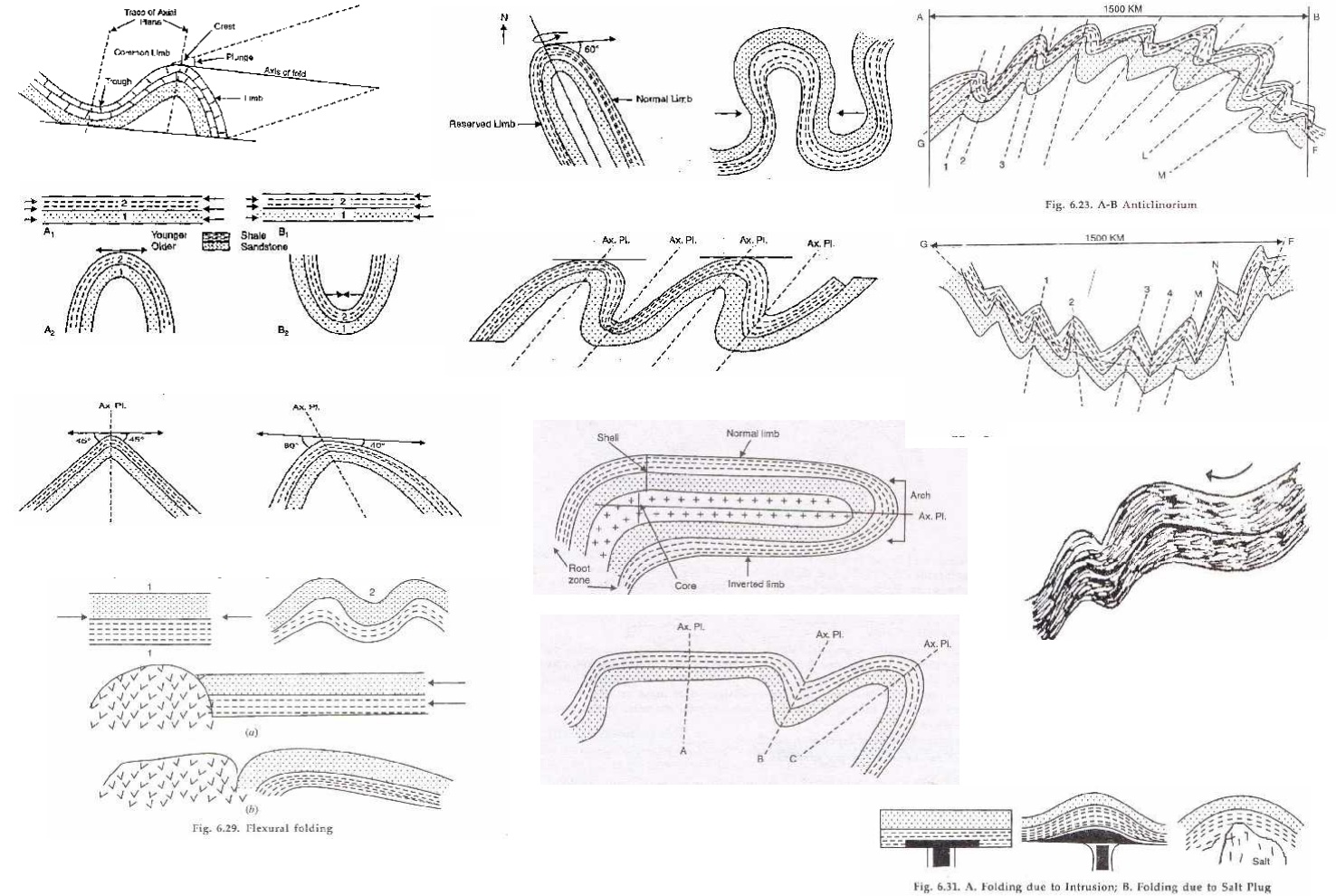
Structural
Geology: Folds
Definition
Ø FOLDS may
be defined as undulations or bends or curvatures developed in the rocks of the
crust as a result of stresses to which these rocks have been subjected from
time to time in the past history of the Earth.
Development
of folds
Ø The folds
may develop in any type of rock and may be of any shape and geometry ranging
from simple up arched bends or downward curvatures to completely overturned
flexures.
Ø The
ultimate shape and extent of a fold depends upon a number of factors like the
nature, magnitude and the direction of and duration for which these forces act
upon the rocks and also the nature of the rocks being effected.
Ø The
process of development of folds in the rocks is called Folding.
Ø It is a
very slow geological process and indicates an effort of the rocks in a
particular environment to adjust themselves to the changing force fields
operating on, within or around them.
Ø Folding
is a ductile type of deformation experienced by the rocks compared to the
brittle deformation where the rocks actually get broken and displaced when
stressed.
1 PARTS OF
A FOLD
Limbs
Ø These are
the sides or flanks of a fold. An individual fold will have a minimum of two
limbs but when the folds occur in groups, as they very often do, a middle
limb will be common to two adjacent folds.
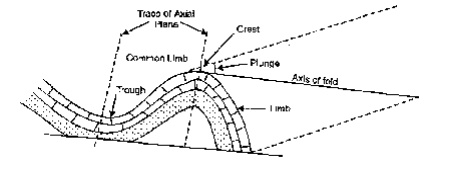
Hinge
Ø In a
folded layer, a p oint can be found where curvature is maximum and one limb
ends and the other li mb starts from that point. This is the hinge poin t.
Ø When
rocks occur in a sequence and their all hinge points are joined together, they
make a line, called the hinge line.
Axial surface
Ø When the
hinge line is traced throughout the depth of a folded sequence a surface is
obtained which may be planar or non-planar. It is referred to as axial surface
Axial plane
Ø Axial
plane is the im aginary plane that passes through all the points of maximum
curvature inclined or horizontal in nature.
Ø A fold
surface is plan ar in nature; otherwise it in a folded sequence.
Ø It may be
vertical, is sometimes called a planar fold if the axial is a n on-planar fold.
Axis of a fold
Ø It is simply defined a s a line drawn
parallel to the hinge line of a fold .
Ø A more
precise defin ition of an axis of a fold would be the line repr esenting the
intersection of the ax ial plane of a fold with any bed of the fold.
Plunge of a fold
Ø The angle
of inclination of the fold axis with the horizontal as meas ured in a vertical
plane is term ed the plunge of the fold.
Crest and Trough.
Ø Most folds are variations of two general forms;
uparched and downarched bends. The line running thr ough the highest points in
an uparched fold defi nes its crest.
Ø A corresponding lin e running through the lowest
point in a down arched fold makes its trough. The crest and trough may or may
not coincide wit h the axis of the fold.
2.CLASSIFICATION OF FOLDS
Anticlines are defined as tho se folds in which
the
strata are uparch ed, that is, these become CONVEX UPWARDS ;
![]()
the geologically olde r rocks occupy a position in
the interior of the fold, oldest being positioned at th e core of the fold and
the youngest forming the outermost flank,
![]()
the limbs dip away from each other at the crest in
the simplest cases.
Synclines
the
strata are downar ched, that is, these become CONVEX DOWNWARDS;
![]()
the geologically younger rocks occupy a position
in the core of th e fold and the older rocks form the outer flanks, provided
the normal order of superposition is not d isturbed,
![]() in the simplest cases in
synclines, the limbs dip towards a common c enter.
in the simplest cases in
synclines, the limbs dip towards a common c enter.
![]()
Position of Axial Plane
Depending upon the nature a nd
direction of the stresses the axial plane in a r esulting fold may acquire any
position in space, that is, it may be vertical, inclined or eve n horizontal.
Following main types are re cognized on the basis of position of the axial
plane in the resulting fold:
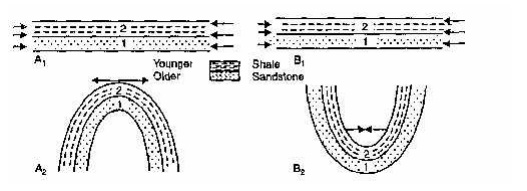
Symmetrical Folds
Ø These are
also called normal or upright folds. In such a fold, the axia l plane is
essentially vertical.
Ø The limbs
are equal i n length and dip equally in opposite directions.
it may be an anticline or syncline and when
classified, may be described as symmetrical anticline / syncline as the case
may be.
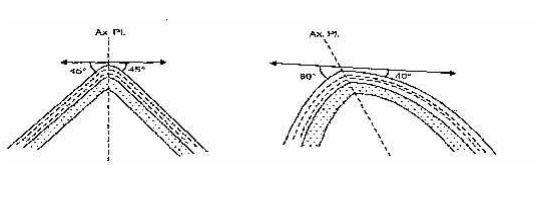
Asymmetrical Folds
All those folds, anticlines or synclines, in which
the limbs are unequ al in length and these dip uneq ually on ether side from
the hinge line are termed as asymmetrical folds.
Overturned
folds
Ø These are
folds with inclined axial planes in which both the limbs are dipping
essentially in the same general direction.
Ø The
amount of dip of the two limbs may or may not be the same.
Ø Overfolding
indicates very severe degree of folding.
Ø One of
the two limbs (the reversed limb) comes to occupy the present position after
having suffered a rotation through more than 90 degrees.
The other limb is known as the normal limb.
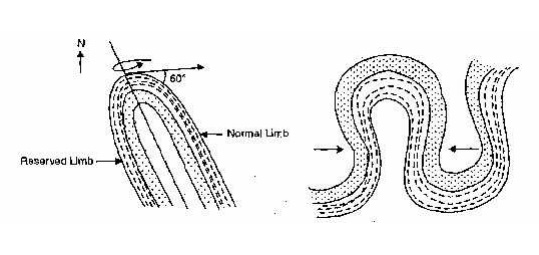
Ø In certain cases, both the
limbs of a fold may get overturned because of very high lateral compression.
Ø It may be
originally either an anticline or a syncline but the extreme compression from
opposite sides results in bringing the limbs so close to each other that the
usual dip conditions may get reversed -anticlinal
limbs dip towards each other and the synclinal limbs dip away from each other.
Ø Such a
type of fold is commonly referred to as a fan fold
Ø In such
folds, the anticlinal tops are said to have opened up into a broad, fan-shaped
outline due to intense compression in the lower region.
Isoclinal
Folds
Ø These are
group of folds in which all the axial planes are essentially parallel, meaning.
that all the component limbs are dipping at equal amounts.
Ø They may
be made up of series of anticlines and synclines
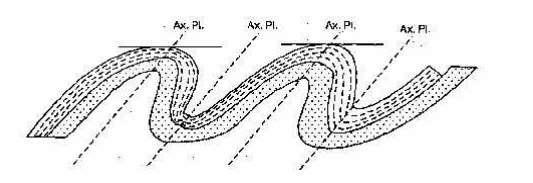
Recumbent Folds
Ø These may
be described as extreme types of overturned folds in which the axial plane
acquires an almost horizontal attitude.
Ø In such
folds, one limb comes to lie exactly under the other limb so that a drill hole
dug at the surface in the upper limb passes through the lower limb also.
Ø The lower
limb is often called the inverted limb or the reversed limb.
Ø Other parts
of a recumbent fold are sometimes named as follows:
the arch, which
is zone of curvature corresponding to crest and trough in the upright folds;
the shell, which is the outer zone made up
mostly of sedimentary formations;
the core, which
is the innermost part of the fold and maybe made mostly of crystalline igneous
or metamorphic rocks;
the root or the root zone, which
is the basal part of the fold and may or may not be easily traceable;
once traced it can throw light whether the fold was originally an anticline or
syncline that has suffered further inversion.
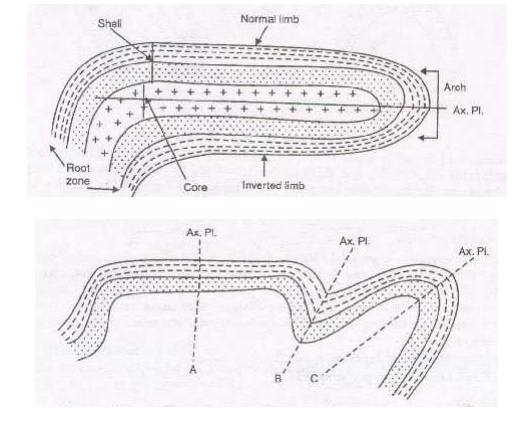
Conjugate Folds
In certain cases a pair of folds that are apparently related
to each other may have mutually inclined axial planes.
Such
folds are described as conjugate folds.
The individual folds themselves may be anticlinal
or synchnal or their modifications.
Box Fold
It may be described as a special type of fold with
exceptionally flattened top and steeply inclined limbs almost forming three
sides of a rectangle.
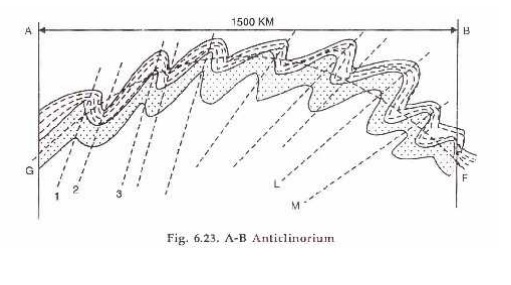
Ø In both
the anticlinorium and synclinorium, presence of large number of secondary
folds, faults and fracture systems is a characteristic feature.
Ø Similar
folding but signifying still larger bending and uplifting of strata on
sub-continental scales is expressed by the terms GEANTICLINES AND GEOSYNCLINES
respectively.
Ø Great
importance is attached to the major depressions, the geosynclines, in the
process of mountain building discussed elsewhere.
Ø The
geosynclines are believed to serve as depositional fields or basins of
sedimentation to which sediments derived by the erosion of the adjoining
gentilities get accumulated and compacted.
Ø This
material is then compressed and uplifted in the second stage of orogeny, to
gradually take the shape of mountain systems.
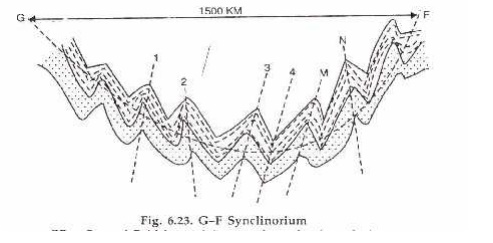
3 CAUSES OF FOLDING
The
Tectonic Folding may be due to any one or more of the following mechanisms:
Folding
Due to Tangential Compression
Lateral Compression is believed to be the main cause for
throwing the rocks of the crust into different types of folds depending upon
the types of rocks involved in the process and also the direction and magnitude
of the compression effecting those rocks.
In general, this primary force is
believed to act at right angles to the trend of folds. under the influence of
the tangential stresses, folding may develop in either of the three ways:
flexural folding, flowage folding and shear folding.
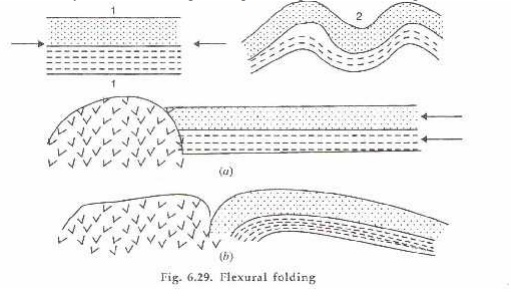
Flexural
Folding.
It is that process of folding in
which the competent or stronger rocks are thrown into folds due to their
sliding against each other under the influence of lateral compression.
This is also distinguished as flexural-slip-folding in which
the slip o r movement of the strata involved takes place parallel to the
bedding planes of the layers.
It has been establis hed that in flexural folding,
the amount of slip (and hence the ultimate type of fold) depends on a number of
factors such as:
thickness o f the layers and nature of the
contact; thick er the layers, greater is the slip; further, cohesionless
contacts favour easy and greater slips;
![]()
distance fr om the hinge point; greater the
distance from the hinge points, larger is the
![]()
displacement,
so much so that it may be negligible at the hin ge point;
![]()
type of the rocks involved; siltstones, sandstones
and li mestones are more prone t o flexure slip folding compared to soft clays
and shales.
![]()
Flowage Folding
Ø It is t
he principal process of folding in incompetent or weaker, plasti c type of
rocks such as clays, shales, gypsum an d rock salt etc.
Ø Duri ng
the compression, the material of the involved layers behaves almost as a
viscous or plastic mass and gets buckled up and d eformed at varying rates
suffering unequal disto rtion.
Ø In such
cases the thickness of the resulting fold does not remain unifor m.

Shear Folding.
Ø In many
cases, folding is attributed to shearing stresses rather than simple
compression.
Ø It is
assumed that in such a process, numerous closely spaced fractures develop in
the rock at the first stage of the process.
Ø This is
followed by displacement of the blocks so developed by different amounts so
that ultimately the rocks take up folded or bent configuration.
Ø The
folded outline becomes more conspicuous when the minor fractures get sealed up
due to subsequent recrystallisation.
Folding Due to lnsrusions
Ø Intrusion
of magma or even rock salt bodies from beneath has been found to be the cause
of uparching of the overlying strata.
Ø In
magmatic intrusions, highly viscous magma may be forced up very gradually and
with considerable force so that the overlying sedimentary host rocks are bodily
lifted up to provide space for the rising magma.
Ø In extreme cases, the magma may even rupture the overlying strata to flow out as lava

Folding Due to Differential Compression
Ø Strata
that are being compacted under load in a basin of sedimentation develop, with
passage of time, downward bending especially in the zones of maximum loading.
Ø If the
strata in question is not homogeneous, the bending may not be uniform in
character and results in warping or folding of different types.
Ø Such
folds are, however, totally dependent on the load from above and are attributed
to superficial causes.
Ø These
are, therefore, non- tectonic folds.
ENGINEERING CONSIDERATIONS
Ø Folds
developed in the areas of work are important for a civil engineer in that these
make his work more complicated.
Ø If these
structures are not thoroughly investigated and properly interpreted, any civil
engineering project standing on or driven through the folded rocks may prove
not only uneconomical in the ultimate analysis but also, unsafe as well.
Ø Due
consideration is, therefore, always to be given to the presence of folds in
deciding about the designing and construction of such structures as driving of
traffic and hydropower tunnels, selection of sites for dams and reservoirs and
in fixing the alignments of roads, bridges and highways.
Change in Attitude
1 Folding of any type would cause a change in
the attitude (dip and strike) of the same strata in the aerial extent and also
in depth.
2 Hence
same layers may be repeated along an alignment or one or more different layers
may be unexpectedly encountered.
3 If it
happens so and the unexpectedly repeated or encountered layers are of undesirable
nature, the project costs may be effected as also the time schedule and safety
of the project.
Shattering
of Rocks.
1 The
stresses are often strong enough to break or shatter the rocks, especially in
the axial zones, which are the places of maximum concentration of these forces.
2 hence, in
folded rocks, axial regions are likely to be the areas containing fractured
zones.
3
This effect is of utmost importance because
shattered rocks become:
• weak in
strength parameters of all types;
• porous
and pervious in character;
Axial regions in the folded rocks should be thoroughly studied
and if possible, should be avoided for other better alignments or sites as the
case may be.
If it is not possible to avoid them, these areas must be
subjected to suitable processes of rock treatment for developing in them
desired qualities of strength and imperviousness.
Strained
Nature.
1 All the
stresses that have acted on the rocks during their folding are generally
absorbed by these rocks by undergoing strain.
2 In essence,
the folded rocks are considerably strained, the magnitude of strain varying
from point to point in the folded sequence.
3 Now, as
and when there is an effort by nature or by the engineer to disturb this
adjustment of the rocks to the stresses, the rock may respond by release of
some strain energy.
4 Enough
stored strain energy is released as soon as (or soon after) the excavations are
made and huge blocks of rocks start caving in or falling with great force
called the rock bursts.
5 This
often involves fatal accidents besides causing considerable delay in the
progress of the work.
6 A proper
planning of the work in folded areas is, therefore, of utmost importance to
avoid these possible hazards in construction work.
Related Topics